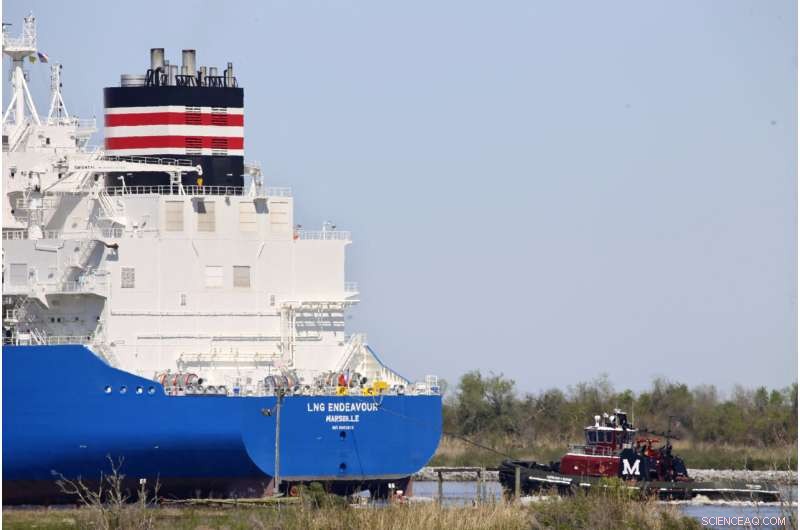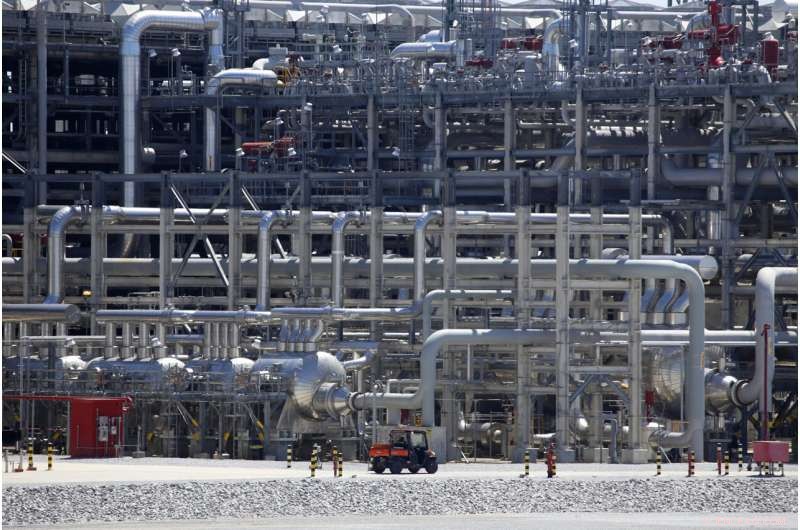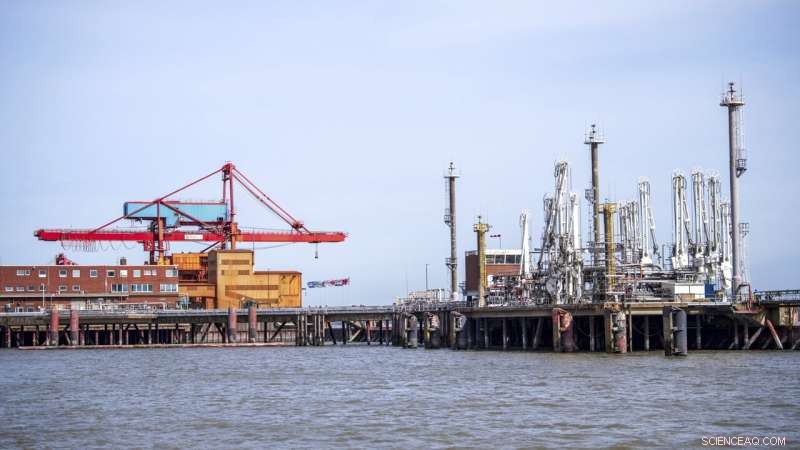
Un remorqueur aide à guider un navire français, connu sous le nom de LNG Endeavour, à travers le lac Calcasieu près de Hackberry, en Louisiane, le 31 mars 2022. La guerre de la Russie contre l'Ukraine a brisé ses relations avec l'Europe, qui a rapidement perdu la majeure partie du gaz naturel que Moscou avait longtemps fourni. Maintenant, à l'approche de l'hiver, les nations européennes ont soutenu une solution à court terme qui devrait commencer avant la fin de 2022, ce qui a sonné l'alarme parmi les scientifiques qui craignent les conséquences à long terme pour le climat. Crédit :AP Photo/Martha Irvine, Fichier
À l'approche de l'hiver, les nations européennes, désespérées de remplacer le gaz naturel qu'elles achetaient autrefois à la Russie, ont adopté une solution à court terme :une série d'environ 20 terminaux flottants qui recevraient du gaz naturel liquéfié d'autres pays et le convertiraient en combustible de chauffage.
Pourtant, le plan, avec les premiers terminaux flottants devant livrer du gaz naturel d'ici la fin de l'année, a sonné l'alarme parmi les scientifiques qui craignent les conséquences à long terme pour l'environnement. Ils avertissent que ces terminaux perpétueraient la dépendance de l'Europe au gaz naturel, qui libère du méthane et du dioxyde de carbone qui réchauffent le climat lorsqu'il est produit, transporté et brûlé.
Certains scientifiques disent craindre que les terminaux flottants ne finissent par devenir un fournisseur à long terme des vastes besoins énergétiques de l'Europe qui pourraient durer des années, voire des décennies. Une telle tendance pourrait faire reculer les efforts de réduction des émissions qui, selon les experts, n'ont pas été assez rapides pour ralentir les dommages causés à l'environnement mondial.
Une grande partie du gaz naturel liquéfié, ou GNL, que l'Europe espère recevoir devrait provenir des États-Unis. Le besoin est apparu après que l'invasion de l'Ukraine par la Russie a brisé ses liens avec l'Europe et a conduit à une coupure de la majeure partie du gaz naturel que Moscou fournissait depuis longtemps. Le long de la côte du golfe des États-Unis, les terminaux d'exportation se développent et de nombreux résidents s'inquiètent de l'augmentation du forage de gaz et de la perte de terres qui en résulte, ainsi que des changements climatiques extrêmes associés à la combustion de combustibles fossiles.
"La construction de cette immense infrastructure de GNL enfermera le monde dans une dépendance continue aux combustibles fossiles et des dommages climatiques continus pour les décennies à venir", a déclaré John Sterman, climatologue au Massachusetts Institute of Technology.
Le gaz naturel contribue de manière significative au changement climatique, à la fois lorsqu'il est brûlé, se transformant en dioxyde de carbone, et par les fuites de méthane, un gaz à effet de serre encore plus puissant. Pourtant, les pays européens, qui pendant des années ont été les leaders du passage à une énergie plus propre, ont proposé d'installer plus de 20 terminaux GNL flottants dans leurs ports pour aider à compenser la perte de gaz naturel russe.
Les terminaux, qui surplombent les maisons et s'étendent sur près de 1 000 pieds (304 mètres), peuvent stocker environ 6 milliards de pieds cubes (170 000 mètres cubes) de GNL et le convertir en gaz pour les maisons et les entreprises. Ils peuvent être construits plus rapidement et à moindre coût que les terminaux d'importation terrestres, bien qu'ils soient plus coûteux à exploiter, selon l'Union internationale du gaz.
"Chaque pays doit se préparer à un scénario où il pourrait y avoir une réduction des approvisionnements russes", a déclaré Nikoline Bromander, analyste chez Rystad Energy. "If you are dependent, you need to have a backup plan."

A flare burns at Venture Global LNG in Cameron, La., on April 21, 2022. Russia’s war against Ukraine shattered its relations with Europe, which soon lost most of the natural gas that Moscow had long provided. Now, as winter nears, European nations have backed a short-term fix set to begin before the end of 2022 that has raised alarms among scientists who fear the long term consequences for the climate.Credit:AP Photo/Martha Irvine, File
Many environmental scientists argue that the money being earmarked for the ships—which cost about $500 million each to build, according to Rystad—would be better spent on rapidly adopting clean-energy or efficiency upgrades that could reduce energy consumption.
Constructing more solar or wind farms, which takes years, wouldn't immediately replace Russian gas. But with adequate funding, Sterman suggested, greater energy efficiencies—in homes, buildings and factories, along with the deployment of wind, solar and other technologies—could vastly reduce Europe's need to replace all the gas it's lost.
Germany, among Europe's strongest advocates for the floating LNG terminals, is expecting five of the ships and has committed roughly 3 billion euros to the effort, according to Global Energy Monitor. Germany has also approved a law to fast-track the terminals' development, suspending the requirement for environmental assessments.
It's a move that troubles environmental groups.
"It's totally obvious," asserted Sascha Müller-Kraenner, CEO of Environmental Action Germany, that "the provisions of the law were developed in close dialogue with the gas industry."
Germany's government and energy industry have defended their embrace of the LNG terminals as an urgent response to the loss of most of the Russian gas they had long received, which they fear Moscow will shut off completely.
"In an exceptional situation such as this, where it's a matter of Germany's gas supply security, it is justified to accelerate the approval process," Germany's energy industry association, BDEW, said in a statement.
Susanne Ungrad, a spokeswoman for Germany's Economy and Energy Ministry, noted that efforts are being made to lower methane emissions in exporting countries like the United States. And she said that in pursuing the construction of LNG terminals, Europe authorities will conduct comprehensive assessments.

A small vehicle drives past a network of piping that makes up pieces of a "train" at Cameron LNG export facility in Hackberry, La., on March 31, 2022. Russia’s war against Ukraine shattered its relations with Europe, which soon lost most of the natural gas that Moscow had long provided. Now, as winter nears, European nations have backed a short-term fix set to begin before the end of 2022 that has raised alarms among scientists who fear the long term consequences for the climate. Credit:AP Photo/Martha Irvine, File
Greig Aitken, an analyst at Global Energy Monitor, noted that a terminal that's set to open near Gdansk, Poland, has signed contracts with American LNG suppliers that extend well past 2030. That could make it problematic for the European Union to meet its goal of reducing greenhouse gas emissions by at least 55% by 2030.
Italy, Greece, France, the Netherlands, Croatia, Estonia, Finland, Latvia, Slovenia and the U.K. all have one or more floating LNG terminals planned, according to Rystad Energy.
In some cases, proponents argue, the ships could aid the environmental cause. They note, for example, that as Russian gas supplies have dwindled, communities in Germany and elsewhere have been burning coal, which typically produces more emissions than natural gas. Increasing the supply of natural gas would make this less necessary.
Still, methane can frequently leak along the natural gas supply chain. So in some cases, the net climate effect of burning natural gas may be no better than coal.
The U.N. Intergovernmental Panel on Climate Change has warned that continuing to use the fossil fuel infrastructure already in place would cause global warming to exceed 1.5 degrees Celsius (2.7 Fahrenheit). At that level, heat would be expected to worsen the flash floods, extreme heat, intense hurricanes and longer-burning wildfires that have resulted from climate change and have cost lives.
"It is a little disheartening to see Europe, which has been the seat of so much energy and action and bold emissions targets, being home to this particular way with doubling down on fossil fuel infrastructure," said Kim Cobb, a climate scientist at Brown University.
In the United States, the largest export market for Europe-bound LNG, three new export terminals are under construction. Eleven additional terminals and four expansions are in the planning stages. Some export terminals that had struggled to attract financing are now seeing more investment and interest, said Ira Joseph, a longtime energy analyst.
"What you've seen happen over the last two months—they're signing up sales and purchase agreements, right and left," Joseph said.

The area in front of the Stade Industrial Park is part of the future port expansion for the planned import terminal for liquefied natural gas (LNG) in Stade, Germany, on April 2022. Russia’s war against Ukraine shattered its relations with Europe, which soon lost most of the natural gas that Moscow had long provided. Now, as winter nears, European nations have backed a short-term fix set to begin before the end of 2022 that has raised alarms among scientists who fear the long term consequences for the climate. Credit:Sina Schuldt/dpa via AP, File
Rio Grande LNG, an export terminal proposed by Next Decade in Brownsville, Texas, for example, appeared to stall last year in the face of environmental protests. But this spring, a French company, Engie, and several clients in Asia signed long-term contracts to buy LNG from the terminal. Now, Next Decade says it's likely to obtain all the financing it needs.
Europe's gas scarcity has escalated global LNG prices, leading buyers in China and elsewhere to sign long-term contracts with suppliers in the United States. American LNG exports will likely grow by 10 million tons over the next year, said Bromander, the Rystad analyst.
The floating LNG ships have been billed as a short-term solution to keep gas flowing for a few years while cleaner energy sources like wind and solar are built up. But critics say it's unlikely that a ship built to last decades would permanently halt operations after a few years.
Once the floating terminals are built, they can be used anywhere in the world. So if European nations no longer want floating LNG terminals as they transition to cleaner energy, the ships could sail off to another port, essentially locking in the use of natural gas for decades.
And in some cases, particularly in Germany, some of the proposed floating terminals appear to be paving the way for on-shore terminals that would be built to last 30 or 40 years—well past the point that nations should be burning fossil fuels, environmental groups say.
"After the war is resolved and, as we all hope, peace is restored, are they really going to say, 'Oh, let's take it to the scrap yard?,'" Sterman asked. "They're not going to do that."
© 2022 L'Associated Press. Tous les droits sont réservés. Ce matériel ne peut être publié, diffusé, réécrit ou redistribué sans autorisation. EU decision on natural gas could threaten climate progress